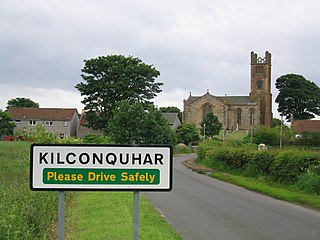
Kilconquhar is a village and parish in Fife in Scotland. It includes the small hamlet of Barnyards. It is bounded by the parishes of Elie, Ceres, Cameron, St Monans, Carnbee, Newburn and Largo. It is approximately 9 miles from north to south. Much of the land is agricultural or wooded. The village itself is situated inland, north of Kilconquhar Loch. Also in the civil parish are Colinsburgh and Largoward, the latter since 1860 being a separate ecclesiastical parish.

Balcarres House lies 1km north of the village of Colinsburgh, in the East Neuk of Fife, in eastern Scotland. It is centred on a mansion built in 1595 by John Lindsay (1552–1598), second son of David, 9th Earl of Crawford. The house became the family seat of the Earl of Crawford. The present house is the result of substantial extensions in the early nineteenth century, using part of a fortune made in India, but preserves much of the original mansion.

Colinsburgh is a village in east Fife, Scotland, in the parish of Kilconquhar.

Largoward is a village in East Fife, Scotland, lying on the road from Leven to St Andrews in the Riggin o Fife, 4½ miles north-east of Lower Largo and 6½ miles south-west of St Andrews. It is an agricultural and former mining village, one of the three main villages of the civil parish of Kilconquhar, along with Colinsburgh and the village of Kilconquhar. Coal must have been worked for a considerable length of time in the district, as it is recorded that coal was driven annually from Falfield, just north-west of the village, to Falkland Palace for the use of King James VI.
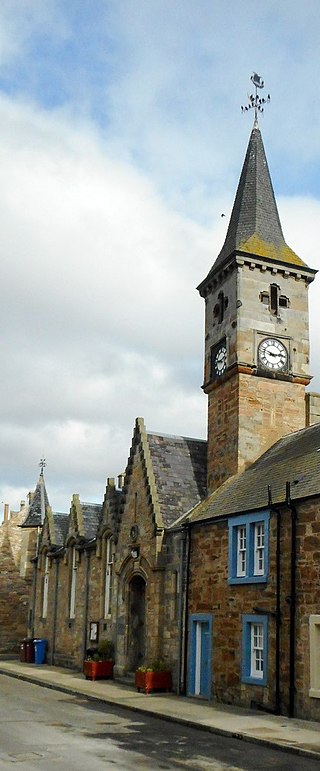
Elie and Earlsferry Town Hall is a former municipal structure in High Street in Elie and Earlsferry, Scotland. The structure, which is currently used as an events venue, is Category B listed.

The Cheese Market in Hay-on-Wye, formerly Hay-on-Wye Town Hall,, is a municipal building in Market Street, Hay-on-Wye, Powys, Wales. The structure, which has been restored with support from the Heritage Lottery Fund so that the first floor can be let out for residential use, is a Grade II listed building.
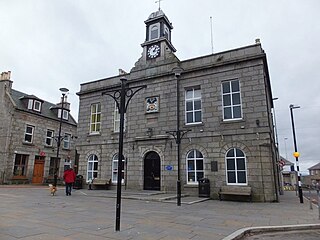
Oldmeldrum Town Hall is a municipal structure in the Market Square, Oldmeldrum, Aberdeenshire, Scotland. The structure, which is used as a community events venue, is a Category B listed building.
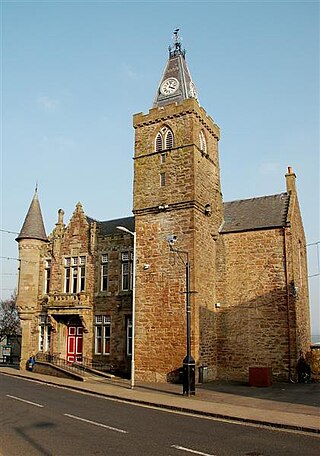
Maybole Town Hall is a municipal structure in the High Street in Maybole, South Ayrshire, Scotland. The structure, which is used as a community events venue, is a Category B listed building.

Campbeltown Town Hall is a municipal structure in Main Street in Campbeltown, Argyll and Bute, Scotland. The structure, which is used as a community events venue, is a Category B listed building.

Cove Burgh Hall is a municipal structure in Shore Road in Cove, Argyll and Bute, Scotland. The structure, which is used as a community events venue, is a Category B listed building.

Falkland Town Hall is a municipal building in the High Street, Falkland, Fife, Scotland. The structure, which has been converted for use as offices and as shops, is a Category A listed building.
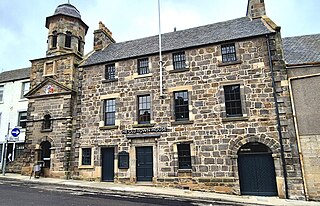
Inverkeithing Town House is a municipal building in the Townhall Street, Inverkeithing, Fife, Scotland. The structure, which is used as a base by members of the local community council, is a Category A listed building.

Dysart Tolbooth and Town House is a municipal building in the High Street, Dysart, Fife, Scotland. The structure, which was comprehensively restored in 2009, is a Category A listed building.

Pittenweem Parish Church and Tolbooth Steeple is an ecclesiastical and municipal complex in the High Street, Pittenweem, Fife, Scotland. The structure, which is used as the local parish church, is a Category A listed building.

Dreel Halls is a municipal complex in Elizabeth Place, Anstruther Wester, Fife, Scotland. The complex, which is used as a community events venue, consists of the former St Nicholas's Parish Church, which is a Category A listed building, and the former Anstruther Wester Town Hall, which is a Category C listed building.

Lossiemouth Town Hall is a municipal building in the High Street in Lossiemouth, Moray, Scotland. The building is currently used as a community events venue.
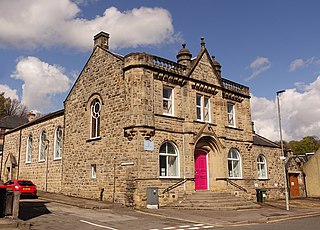
Grant Hall, formerly Rothes Town Hall, is a municipal building in New Street, Rothes, Moray, Scotland. The structure is currently used as a community events venue.

Milnathort Town Hall is a municipal building in New Road, Milnathort, Perth and Kinross, Scotland. The structure, which is currently used as community events venue, is a Category B listed building.

Stocksbridge Town Hall is a municipal building in Manchester Road in Stocksbridge, a town in South Yorkshire in England. The town hall, which was previously the offices and meeting place of Stocksbridge Urban District Council, is now the home of Stocksbridge Town Council as well as other community organisations.

Kirkcaldy Sheriff Court, formerly known as County Buildings, is a judicial building on Whytescauseway in Kirkcaldy in Scotland. The building, which continues to operate a courthouse, is a Category B listed building.





















